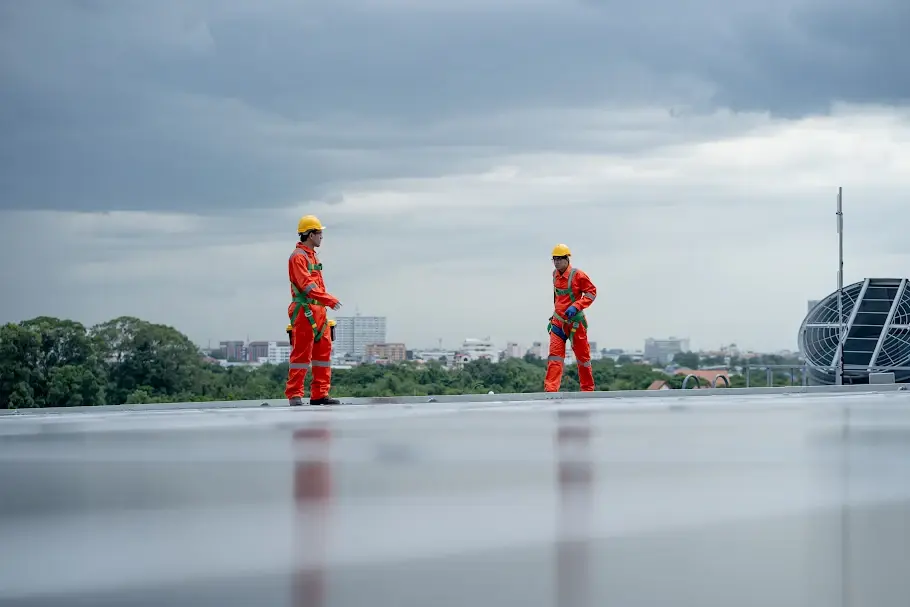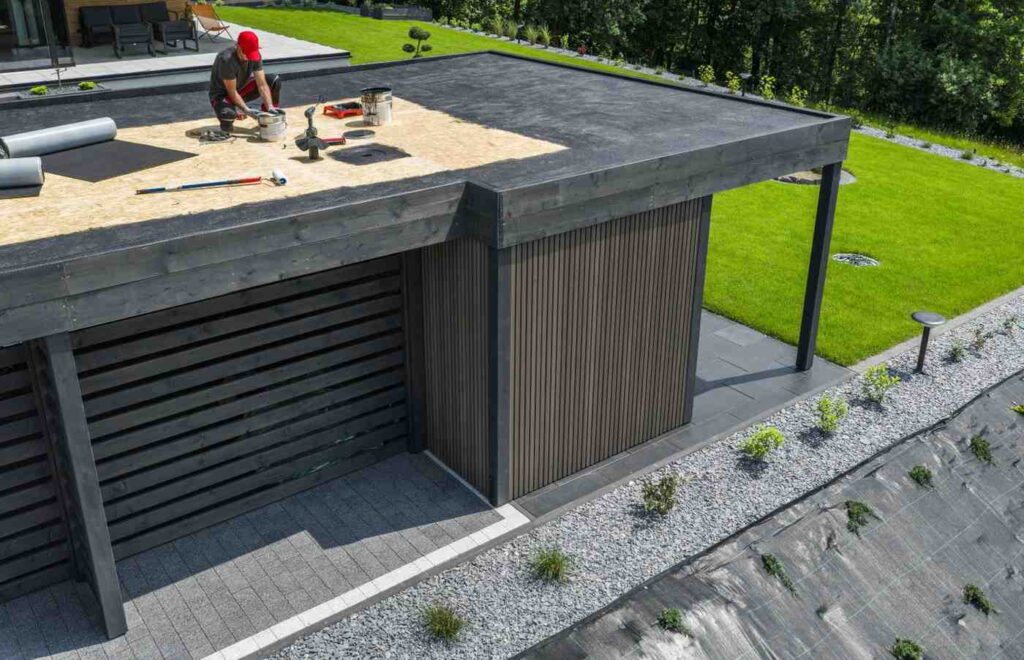TPO roofing has become one of the fastest-growing, reliable, affordable, and efficient options for commercial roofing. If you are constructing a new property or replacing an existing roof, it is a smart choice to consider and understand what TPO roofing is and if it is appropriate for your building. The knowledge gained in this article can save you significant amounts of time, money, and stress! In this guide from Flat Roofs by Pegram, we will discuss what TPO roofing is, how it works, the benefits and downsides, installation tips, and cost breakdowns.
What Is TPO Roofing?
TPO (Thermoplastic Polyolefin) is a single-ply roofing membrane made from a blend of rubber and other fillers. It’s typically white and highly reflective, designed for flat or low-slope roofs, and commonly found in commercial buildings.
Let’s understand the key things about TPO roofing that every homeowner should know before installing it:
Key Components of TPO Roofing
The roofing system of TPO is made up of fundamental components that give strength and performance: an extended-life membrane, a polyester-reinforced scrim, and a reflective top coat to add efficiency.
- Membrane: The main component is made from TPO polymer, reinforced with polyester.
- Scrim: A reinforcing fabric that bonds the layers of roofing and adds strength and stability.
- Top layer: The UV-resistant, heat-reflective surface is generally a shade of white or light gray.
TPO Roofing Installation: Step for a Seamless Finish
TPO roofing installation is an advantageous way to ensure your flat roofing will remain waterproof and energy efficient. So, what does this roofing installation entail? Just as with any other roofing installation, TPO roofing installation is a systematic process that aims to install a durable and effective roof system.
The following steps should be followed for an effective TPO roof:
| Steps | What to do? |
| Step 1 | Clear the Roof Decking |
| Step 2 | Install the Roof Insulation |
| Step 3 | Rolling Out the TPO |
| Step 4 | Securing Your TPO Membrane |
| Step 5 | Adhering Your TPO Seam |
| Step 6 | Installing Flashing |
| Step 7 | Getting a Final Roof Inspection |
Cost of TPO Roofing
The pricing for TPO roofing is dependent on multiple factors such as material, installation, repairs, and maintenance. It is important to understand these parts of the project so that you can plan logically and with a budget in mind.
Below is a breakdown of TPO roofs’ costs in 2025:
| Category | Cost per Square Foot |
| Material | $1.00 – $2.50 |
| $1.00–$2.50 | $4.00 – $7.50 |
| Repairs & Maintenance | $0.50 – $2.00 |
| Replacement | $1.00–$2.50 |
TPO vs PVC vs EPDM Roofing
Let us take a look and understand what makes TPO roofing different from PVC and EPDM Roofing:
| Feature | TPO Roofing | PVC Roofing | EPDM Roofing |
| Material | Thermoplastic polyolefin (rubber blend) | Polyvinyl chloride (plastic-based) | Ethylene propylene diene monomer (rubber) |
| Color | White/light gray (reflective) | White, gray, tan (reflective) | Black (absorbs heat) |
| Energy Efficiency | High – reflects UV, lowers cooling costs | High – also reflective | Low – absorbs heat unless coated |
| Durability | Resists punctures, dirt, and mold | Strong chemical resistance | Very flexible, good in cold climates |
| Eco-Friendliness | Recyclable, chlorine-free | Contains chlorine, less eco-friendly | Long lifespan, but less recyclable |
| Lifespan | 20–30 years | 20–30 years | 25–35 years |
| Maintenance | Moderate – seams need inspection | Moderate – chemical exposure can cause wear | Low – simple patching and sealing |
| Cost (Installed) | $5–$9 per sq. ft. | $7–$12 per sq. ft. | $4–$8 per sq. ft. |
| Best Use | Balanced option for most flat roofs | Chemical-heavy environments (restaurants, factories) | Budget-friendly roofs in colder areas |
Why TPO Roofing Is the Smart Choice
TPO roofing emerges as one of the top choices for flat roofs, thanks to its energy efficiency, durability, and affordability. Proper installation and regular maintenance are essential to help you get the longest life and best performance out of TPO roofing, given its expected lifespan.
Here’s why you should install TPO roofing:
Energy Efficiency
TPO is white, a coating that reflects UV light, and causes significant reductions in cooling expenses in hot climates. TPO helps buildings to achieve Energy Star and LEED criteria.
Durability
TPO is resistant to molds and dirt punctures and can withstand weather, cyclical expansion and contraction, and seasonal snow.
Cost-Effective
While TPO is less expensive than other single-ply materials such as PVC, TPO performs similarly in many areas.
Eco-Friendly
TPO roofing is free from chlorine and harmful chemicals, making it an eco-friendly option that is 100% recyclable at the end of its service life.
Ease of Installation
The material is lightweight for ease of moving and can be mechanically fastened, fully adhered, or ballasted, creating a range of installation options.
Conclusion
TPO roofing provides a great option, as it balances price, longevity, and energy performance. It can last over 20 years if installed and maintained properly and can lower your energy bills. All roofing investments being made, success ultimately rests with quality materials and installation. If considering TPO for your property, be sure to compare quotes, warranty stipulations, and contractor experience. It’s one of the best flat-roofing material choices available today because it is smart, sustainable, and ready for the future.
FAQs
1: Is TPO roofing suitable for residential homes?
Yes. TPO works well for flat or low-slope residential roofs. It offers energy savings and durability, but homeowners should consult a roofer to confirm suitability for their local climate.
2: Can TPO roofing be repaired?
Yes. Small punctures, seam separations, or tears can be patched or heat-welded. Regular inspections help catch minor issues early.
3: How do I choose a reliable TPO contractor?
Choose a certified installer, check past TPO projects, and confirm the manufacturer’s warranty. Local experience is a strong trust signal.
4: How long does TPO roofing last?
On average, TPO roofing lasts 20–30 years with proper installation and maintenance. Extreme weather can shorten or extend its lifespan.
5: Is TPO roofing fire-resistant?
Yes. Most TPO membranes meet fire-resistance standards, adding extra safety for commercial and residential buildings.
6: How does TPO compare to other roofing types?
TPO is cheaper than PVC and often more durable than EPDM. It balances cost, energy efficiency, and eco-friendliness, making it a smart choice for flat roofs.




